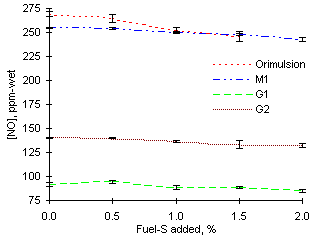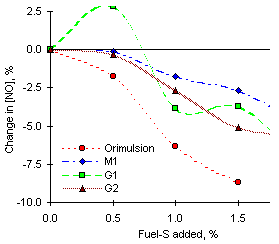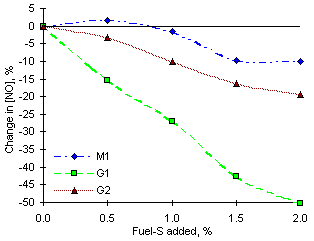 = 0.833)
= 0.833) = 0.833)
= 0.833)
 = 0.833
= 0.833
Emissions of NO were higher under fuel-lean conditions ( = 0.833) than at any other equivalence ratio. Large concentrations of oxidising species favour the formation of NO over other compounds (see NO formation mechanism).
= 0.833) than at any other equivalence ratio. Large concentrations of oxidising species favour the formation of NO over other compounds (see NO formation mechanism).
A net reduction of NO emissions was observed from all fuels investigated when SO2-gas was added to the combustion system at fuel-lean equivalence ratios.
The largest reduction of NO emissions was obtained from Orimulsion, by 23.4 ppm-wet (ie 8.71 % of the initial emissions) on addition of 1.5 % fuel-S.

 = 0.833 from experiments of sulphur addition from all fuels investigated
= 0.833 from experiments of sulphur addition from all fuels investigatedThe nominal and percentage reductions obtained from the heavy gas oils (both coker and vacuum) were within a narrow range, between 5 and 7 % on addition of 2 % fuel-S. The percentage decreases of NO emissions from these fuels were lower than those from Orimulsion, and seemingly independent of the initial nitrogen and sulphur contents (see analyses of fuels in "Appendix II"). This effect can be observed in Figure 128, which shows the percentage change of NO emissions from all fuels investigated.
 = 1.000)
= 1.000)

 = 1.000 from experiments of sulphur addition from the fuels investigated
= 1.000 from experiments of sulphur addition from the fuels investigatedAddition of sulphur dioxide caused a decrease of NO emissions from all of the fuels studied at this equivalence ratio (see Figure 129). The decrease was maximum for fuel G1, from which a reduction of 11.5 ppm-wet was obtained on addition of 2 % fuel-S. This represented a 50 % drop from the emissions of NO in absence of sulphur dopant. Decreases from other fuels were smaller, ie 6.3 ppm-wet (10.1 %) for fuel M1, and 9.5 ppm-wet (19.4 %) for fuel G2.
3.1.3. Fuel-rich conditions (
Emissions of NO at fuel-rich conditions were minimum among those at all equivalence ratios studied, caused by the absence of oxidising species. Only fuel G2 showed significant emissions of NO. Experimental readings were 9 ppm-wet (fuel M1), 2.5 ppm-wet (fuel G1) and 20.9 ppm-wet (fuel G2).
 = 1.200)
= 1.200)
Measured concentrations of NO2 at this equivalence ratio were much higher and accounted for the largest portion of the emissions of nitrogenous species.
The addition of fuel-S to the combustion system had little effect on NO emissions at fuel-rich conditions. Most readings increased by 2 ppm-wet which, added to the fact that NO readings were almost negligible, resulted in an irrelevant effect of sulphur.
 Previous |  Table of Contents |  Next |